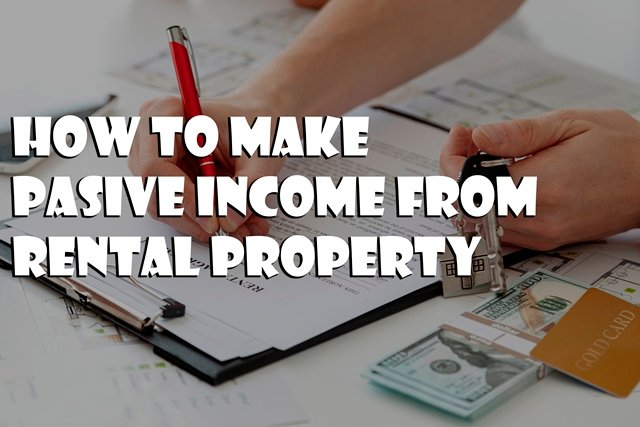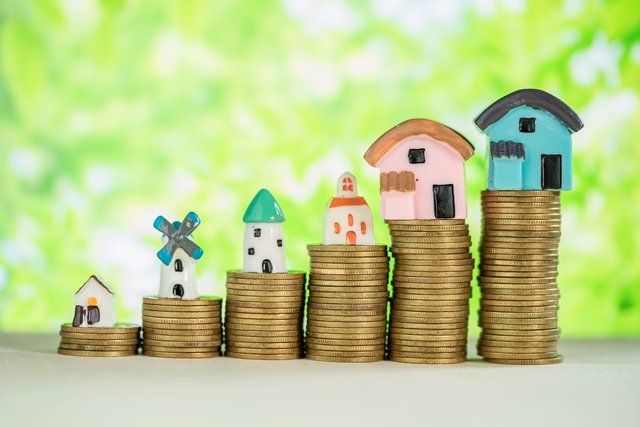Learn how to make passive income from rental property in 2025 with proven strategies. Build steady cash flow, grow wealth, and secure your financial future.
Introduction To Making Passive Income from Rental Property
Investing in rental property is one of the most stable and reliable ways to generate passive income — and in 2025, it’s not something that’s going to be accomplished any differently. Amongst the ocean of fad investments that overwhelm the financial world, the truth of property and rent guarantee makes it the anchor on which to tie your fortune. Your drivers in the market and your determinants of your yields have shifted, then. Higher interest rates, increasing inflation pressure, and shifting renters’ preferences — driven in great measure by work-at-home setups — are all impacting how landlords’ capital is to be invested in the year ahead.
Two ways inflation has reached the market are good. Small Home rents and home prices have increased, allowing landlords to recoup more money per month. On the other hand, management expenses — in the form of ongoing fees — also increased. While this period also saw the flex and remote work movement boost demand on the part of lessees, with much higher lessees now seeking offices in the suburbs or outside the city with greater square footage and ease.
Here in this blog, I am going to take you through the steps on how to be successful investing in the rental property business in 2025 and building sustainable, long-term passive income. From selecting the right kind of property to maximizing profit, staying out of disaster, and making the most of today’s technology, you’ll understand exactly what it takes to set yourself up for success. Whether you are a new investor or an old hand landlord looking to get as much back as you can, these methods will allow you to create a successful portfolio without doing much work.

How to Learn Passive Income by Using Rental Property
To the masses, hearing “passive income” means money flowing into their account with no effort or even little effort. Sure, rental property will provide steady cash flow, but “passive” is a misnomer. Passivity in real estate uses systems, automation, and, in most cases, property managers.
Active involvement is going looking for tenants, dealing with maintenance calls, doing the maintenance, and getting in the rent, all time- and effort-absorbing activities. Passive involvement is the sort you get when someone else does things like such or loads computer programs that do things for them. Having access to online rent collection and property management software, for instance, can save admin time significantly.
Myths there are, and the inclination is to deprioritize effort from newbies. You still make managerial decisions, go over financial reports, and approve high-ticket expense items with a management company in the background. The actual idea isn’t eliminating effort but moving away from operations’ day-to-day tasks and into managing strategically. That is, rental property is passive only insofar as you establish systems.
The Right Type of Rental Property in 2025
There are more types of rental property than ever in 2025, and every single one of them has a specific role as an investment and scale of commitment. From simple house rentals to vacation rentals and business rentals, your form of rental choice will be a giant consideration for your possible income and administrative considerations. Market pressures, work-from-home demands, and shifting tenant needs are forcing demand into new avenues. The decision of the nature of property is reduced to deciding the changes, comparing them with your cost constraints, and reconciling the level of maintenance effort. The most demanded types of rentals to opt for this year are presented below with advantages and disadvantages:
a) Residential Rentals
House for rent—individual houses, condo units, and apartments—are still a good investment property for investors because their demand is consistent. They are also simpler to finance through banks and mortgage firms, especially for beginners. In your case, your tenants normally subscribe for the long term so that your cash inflow is predictable every month. Low maintenance is needed, except that the location and condition of the property play a big part in determining rent. Inner city suburbs with a new supply of housing and outer suburbs within commuting distance of home-work nodes are especially sought after by residential property investment in 2025.
b) Short-Term & Vacation Rentals
Short-term rentals like Airbnb, Vrbo, and high-end vacation rentals were extremely hot due to the post-pandemic travel rebound. They tend to produce more revenue per night than typical leases, especially in resort areas. They also require more handling by hand, additional housekeeping, and ongoing guest interaction. Local regulations and licensing procedures may be cumbersome as well, so investors will have to do their compliance research before opening. To those willing to embrace technology, dynamic pricing software and check-in automation can optimize return with fewer day laborers.
c) Multi-Family Units
Multi-family buildings—duplexes, triplexes, and apartment buildings—possess economies of scale lacking in single-family rentals. With several renters in a single building, there is minimal maintenance cost per renter and risk of vacancy distributed among many different streams of income. Such a design is always attractive to investors for assured cash payments and increased future returns. The initial purchase is more expensive, but easier to finance, as it has great income upon which they can borrow. There is greater demand for multi-family houses in 2025 when housing is at its lowest on the market.
d) Commercial Leases
Commercial leases like office, retail, and storage have longer time frames and may have larger rental fees compared to residential.
They are lower-management-intensity once rented because the tenant will tend to pay on “triple net” rents. They are, however, more business-cycle-sensitive, and vacant periods are longer than in the case of housing markets. Pandemic trends led the demand towards hybrid work-enabled small office buildings and mixed-use buildings. Commercial leases are only an issue if investors conduct research on local business growth patterns prior to investing.
How to Begin Creating Passive Income from Rental Property
Beginning rental property investing in 2025 is all about being forward-thinking. As wonderful as the concept of passive income is, it is all about making smart choices in each step—whether conducting market research or grappling with maintenance.
It’s a case of juggling cash, property opportunities, and tenant satisfaction, and having your eye constantly on profitability in the long term. With property markets becoming more competitive by the day, you need to play with caution as well as accuracy.
The following is a step-by-step guide on how to initiate your rental property business and create sustainable passive income this year.
Step 1: Know the Local Market & Regulations
You must understand the rental possibilities of the area in which you want to invest before investing in any property.
It includes looking at rental return, vacancy, and area demand patterns. Landlord and tenant law, zoning regulations, and transient rental legislation can have a direct influence on your returns. Quality market analysis reports prevent you from making expensive errors and investing where future growth will occur. In 2025, with the utilization of internet rental data sites and AI-based market reports, it will be faster and more accurate.
Step 2: Get Financing
Financing is the lifeblood of rental property investment, and your source can make or break profitability.
There is the term of fixed bank loan payment term, and the interest rate may be lower in credit unions. A private venture or a joint venture can even be attempted if a down payment is not feasible. For forgotten investors, Real Estate Investment Trusts (REITs) are available with means to ends without ownership. The right finance choice would, however, be based on your finances, credit rating, and confidence in future profitability.
Step 3: Purchase at the Appropriate Price
Buying at the appropriate price forms the base for profit return earnings. This entails the use of negotiation skills, persistence within a competitive market system, and avoiding overbidding while making bids. The usage of similar sales of similar properties, understanding the market cycle, and keeping in mind potential possibilities of remodeling costs plays a significant role in determining a wise purchase. A good starting bargaining gives you space space in have competitive rent fees without losing margins of profit.
Step 4: Restore & Get the Property Ready
A calculated and deep thought-designed renovation will even pressure the building’s rentability. Add affordable garnishment that tenants love—such as newly painted bedrooms, refurbished kitchens and bathrooms, and RGB lighting. Functional garnishments, i.e., additional storage or washer/dryers per unit, will attract better-paying renters, as well. Green upgrades, such as solar panels and low-flow showerheads in 2025, can distinguish your building and lower your utilities to a minimum.
Step 5: Choose Management Style
Your management choice will make your rental income really “passive” or not. Doing it yourself is thrifty but time-consuming for tenant screening, maintenance management, and rent collection. Going with a property management company saves elbow grease at your expense—usually 8–12% of the monthly rent. The choice is on your calendar, experience, and willingness to stay hands-on in day-to-day action.
Step 6: Set Competitive Rent
Overcharging rent generates vacancies, but undercharging drains your profit. Compare your property to similar listings to price effectively without compromising the house. Think about what sets your property apart—its amenities, location, and top features. Smooth pricing strategies—such as move-in credits or bundling utilities—will attract top-quality tenants sooner.
Step 7: Automate Systems
The software makes a rental into an honest passive income from the very first use of the software. Maintenance software via the internet, rent-collecting software, and electronic signatures conserve time and paper use. Artificial intelligence chatbots are being increasingly used by most of the 2025 property owners for communication with the tenants, thus enhancing response time and tenant satisfaction.
Driven Rental Income to the Max in 2025
Maxing rental income in 2025 isn’t about increasing rent levels — it’s about smart value-add to your building, tenant optimization, and being up to date. With increased competition and increasing interest rates, landlords will need to become smart about how they maximize.
A neat, clean, and well-maintained property in the right area can always be capable of securing a premium rent, but investors can also gain by embracing new technology and control management methods. Investors who follow an active amenity conservation and maintenance policy will enjoy lower turnover and healthier occupancy. The policy is to put your building in tune with the hopes of prospective tenants. Future renters in today’s world want convenience, sustainability, and sophistication.
Small-frill amenities such as adding in-unit laundry, stainless steel appliances, or cable for high-speed internet are sufficient to warrant rent hikes. Smart thermostats, LEDs, and solar panels both appeal to environmentally conscious renters as well as lower utility bills, a golden amenity sale opportunity for aggressive rental communities. A second at-the-front-of-your-mind consideration is streamlining your tenant screening and retention strategy. The greatest protection against forfeited rental revenue is quality-paying tenants who pay promptly and remain long-term.
Comprehensive background checks, employment verifications, and establishing expectations lower late payment and turnover. After securing a quality tenant, goodwill relationships are established by way of early repair, regular inspection of the property, and the occasional discount on rent, resulting in renewal rates. Retention is less costly than turnover, and therefore, tenant satisfaction is a hidden component of revenue maximization. Finally, income stream diversification is used in the return maximization service. It may be premium pricing for high-end lots, delivery of fitted-out rentable units, or provision of ancillary services such as cleaning or package receipt for hire.
Others are also rewarded with open lease terms, such as corporate lease or temporary and which can readily generate additional monthly charges if properly managed. Through product diversification, property upgrades, and the nurturing of friendly relationships with tenants, landlords set themselves up for long-term profitability in rent through 2025 and even more.
Passive Real Estate Investment Trusts (REITs)
Income To the rest who want the benefits of real estate without being hassled with real properties, the REITs are the best even in 2025. REITs owning, operating, or financing real property that produces revenues and pays back a staggering percentage of their revenues as dividends are available.
They enable investors to invest in costly real estates, such as malls, office buildings, hospitals, or apartments, without ever taking possession of them, much less managing them. This renders REITs the most liquid passive investing vehicle out there that one can invest in on behalf of the real estate investing universe. The most liquid aspect of REITs is arguably the highest quality of REITs.
While other types of real estate investments just collect dust on the balance sheet for months, traded REITs are stock-like and can be adjusted in real-time by shareholders.
This adaptability is well worth its gold value in a fast-moving market where circumstances, prices, and performance within a line of business may change overnight. To the more easy-going investor, REITs spare him the hassle of handling tenants, property upkeep, and compliance issues but provide him with steady cash flows. Diversification is another advantage. An investment in a REIT is literally an investment in a diversified portfolio of properties, historical properties, geographically and industrially.
This mitigates the danger of holding a single property in a single market. For instance, the requirement for office space decreases in a geographical location, and losses are compensated by industrial or health care property gains in the REIT portfolio. The majority of REITs have niche spaces such as data centers, logistic warehouses, or renewable machinery—spaces well positioned to grow over the next two years. REITs also become attractive to income-strivers as they pay dividends regularly. Under the law, in the majority of situations, REITs are required to pay at least 90% of taxable income to the shareholders.
They are therefore suitable for retirees or any person requiring a steady stream of cash. In 2025, certain REITs are making money by investing in buildings such as those that remain up to date with new trends, including green-certified buildings, retirement living developments, and e-commerce distribution hubs. While REITs are not risk-free—yes, their value declines when the stock market declines—theirs is otherwise one of the simplest ways to generate passive returns on real estate without the headache of direct property management.
Long-Term Strategies to Generate Ongoing Passive Income
Portfolio creation is a diversification plan for cash flow and minimizing reliance on one asset. Leverage of equity by using the properties to borrow funds can be employed to finance more purchases without selling assets. Blending different types of property — i.e., swapping short-term holiday lets for secure residential tenancies — can diversify risky businesses with safer cash flows.
Growth properties with strong economic drivers ensure long-term demand while investing. Having someone else handle leasing off to professionals can ultimately leave your portfolio hands-free, thereby creating a true passive income machine.
Advantages of Building Passive Income in Rental Property:
- Safe Cash Flow – Eliminating a mortgage with stable rent, allowing for investment in other areas.
- Property Appreciation – Investment increases in value from time to time, and makes equity.
- Tax Benefits – Devaluation and government tax expenses decrease the taxable income.
- Hedge Against Inflation – Rent raises with inflation, if you aren’t keeping the rate with purchasing power at that time.
- Advantages of Leverage – Low down payments, but leverage the quality property to earn maximum return.
Disadvantages and Risks of Rental Property Income
- High Initial Costs – Closing, down payment, and rehab take a lot of initial cash.
- Tenant Problems – Non-payment, lawsuits, or damage will interrupt cash flow.
- Market Decline – Excess or downturn might ruin demand.
- Maintenance Expense – Maintenance and replacement can devour profit.
- Work & Time – Even “passive” rentals need constant supervision.
FAQS:
1. Is rental property a good passive income source in 2025 still?
Yes, rental property is a viable source of passive income in 2025, with high rental demand, low housing supply, and increasing property appreciation. Smart property investment and effective management are the keys.
2. How much investment money do I need to invest in a rental property?
The figure is variable, but you usually require as much as it will cost for a down payment (usually 15–25% of the property’s price), closing costs, and a repair budget. Unconventional financing techniques, such as house hacking or joint ventures, reduce entry costs.
3. What is the most financially sound type of rental property?
Short-term rentals offer additional income, but they require higher maintenance and are subject to local government regulations. Long-term rentals are more predictable and less expensive for turnover, and they are best suited for stable passive income.
4. Am I able to achieve passive income from a rental property without having to physically operate it?
Yes, having a property management company will manage tenant problems, rent collection, and repairs. Though it cuts into your profit margin, it will earn you real passive income without your participation.
Conclusion:
Real estate is still a powerful industry for passive, long-term returns in the context of today’s changing 2025 market. Economic changes, public policy, and rental activity will be causes of big returns, but through wisely investing, you can build a portfolio that shows a stable cash flow and value creation for the long term.
Begin small, buy your first small property, and reinvest profits in later units. With preparation, study, and systematic methods, passive rental income can be your lucrative financial future.
References:
- National Association of Realtors. Real Estate Market Trends 2025.
- U.S. Census Bureau. Rental Housing Vacancy and Homeownership Report.
- IRS. Tax Information for Landlords.
- Airbnb. Host Earnings and Pricing Insights 2025.
- Investopedia. REITs: Real Estate Investment Trusts Explained.










